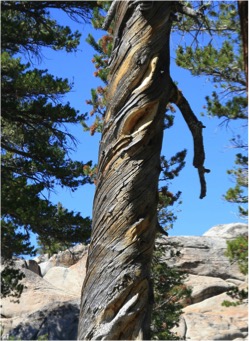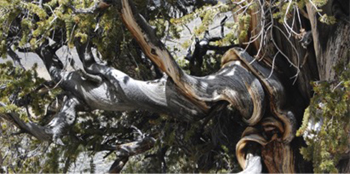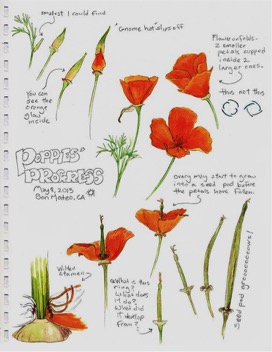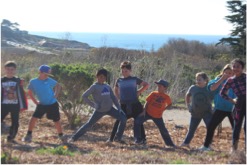|
January 2018 Newsletter
Joyous January
|
Dear ,
Hello and welcome to the New Year! We hope everyone had a wonderful holiday season with big plans for the upcoming year. We are still in the middle of planting season, giving all our baby plants a new place to call home. Hopefully we’ll start getting more rain this month. We’ll be doing a little rain dance! Come out and join us!
Please join us at Rancho Corral de Tierra on Martin Luther King Day, January 15th from 10am-1pm. We will be helping restore grassland habitat for the endangered Hickman’s potentilla by planting our grasses and flowers on a 5-acre parcel in the national park site. Please register here: http://ggnpc.convio.net/site/Calendar?id=118084&view=RSVP.
In This Newsletter:
The Mystery of the Twisted Trunk
By Rosie Frederick
Nothing makes a walk in the woods great quite like a mystery. I stumbled upon one such intrigue a few months ago while hiking in the mountains.
I was trotting along a dusty trail, carefree in the lazy summer afternoon. Along the path lay a downed tree trunk, plucked of its bark and bleached by the alpine sun—it was straight as an arrow but bore a distinct spiraling wood grain.
The spirals were perfectly helical and continued the full length of the trunk, with cracks and knots following the twisted grain. Upon closer inspection, the bark did not appear to be twisted, nor did other nearby trees. Interesting.

|
Lodgepole Pine
Credit: Jane Richardson
|
As one is wont to do on a long solitary hike, I began pondering my find and eventually fixated on the mystery until I reached the trailhead. What on earth caused such a thing? Was this an alpine phenomenon or were all conifers secretly twisty inside? Questions are never more pressing than when Google and phone service are 45 minutes away by car.
The answer was well worth the wait. This spiraling has been the subject of speculation for some time, with theories ranging from the Coriolis force to spirals switching direction in the Southern Hemisphere. As it turns out, there are many potential causes for a helical wood grain.
The first concerns water and nutrient uptake in rocky, difficult environments. When one side of a tree’s roots encounters a barrier to soil, such as a boulder or a cliff, the rest of the roots must provide resources for the entire tree. However, if the grain of the trunk was straight, it could only reach the branches on one side of the tree. Therefore, the trunk twists around to allow every branch equal access to resources from the roots. This is an ingenious way the tree uses to stay healthy in rocky, alpine terrain.
The next explanation involves the environmental stresses put on the trees, like wind or snowfall. Often, the prevailing winds will blow a tree in the same direction for its entire life. If the tree is not growing perfectly straight, this causes a helical stress to be placed on the tree, making it twist away from the force of the wind.
As interesting as these theories are, many questions are still left unanswered. Why do some trees have a clockwise spiral and others a counterclockwise one? Is this phenomenon affected by the shifting position of the sun in higher latitudes? Is there a difference in the spiraling between species?
In many ways, the mystery of the twisted trunk still remains unsolved. So, next time you take a hike in the mountains, keep an eye out for a spiraling trunk among the trees.

|
Bristlecone Pine in the Sierra Nevadas.
Photo Credit: Max Pixel |
“Have you noticed how nobody ever looks up? Nobody looks at chimneys, or trees against the sky, or the tops of buildings. Everybody just looks down at the pavement or their shoes. The whole world could pass them by and most people wouldn't notice.” ― Julie Andrews Edwards, The Last of the Really Great Whangdoodles
What is a Nature Journal and Why Should I keep One?
By Camila Fishtahler

|
| Entry in a Nature Journal by John Muir Laws |
A nature journal is a method of recording what you see and experience—and a way to grow your thoughts, ideas, feelings, and relationship with the natural world. It is an opportunity to interpret your inner thoughts on the natural world and the space where the natural world connects with you.
As I have gotten older I find that I, and others around me, don’t take the time to actually “be” in the moment. Places that are very beautiful just become a corridor for me to get to one place to another.
So, since I’ve started keeping a nature journal, I’ve been amazed how details started to jump out at me. The structure of flowers and their unique colors; the details of a bee’s wing; waves vs. wind patterns; or air quality vs the glorious colors in sunsets. Nature journaling is an exercise for your brain, forcing you look to more closely at your surroundings and learn to connect with it.
"Do you know that trees talk? Well, they do. They talk to each other, and they'll talk to you if you listen...” - Tatanga Mani or Walking Buffalo, Stoney Indian, Canada (1871-1967)
There is no right or wrong way to keeping a nature journal; each journal is as unique as the person keeping it. A journal may be a phenology log; a field guide to plants, animals, geology; or an explorer's log of journeys and findings.
Some journals are used primarily for sketching, drawing, or even storing photographs to record the different organisms seen in various the ecosystems. Other journals, like ones kept up by friends, include stories and detailed descriptions of what they see, hear, and experience while sitting or walking outside—a collection of reflections about a place and connections with it. The majority of nature journals tend to be a hodgepodge of both. Its content is both emotional and intellectual.
There is unspeakable beauty and potential to be found in nature. It entices me and is an invitation I just have to accept. (Jil Ashton-Leigh)

|
| Entry in a Nature Journal by John Muir Laws |
Nature journaling isn’t new. People such as Leonardo da Vinci, Thomas Jefferson, John Muir, Carl Linneaus, and Meriwether Lewis—and more recently Aldo Leopold, Olaus Murie, and Rachel Carson—are among the many scientists, artists, authors, poets, and explorers throughout the ages to record their observations and experiences.
It was through journaling that John Muir composed letters to friends, books, and articles enlisting public support for wilderness preservation. He managed to publish 10 books and over 200 articles from his wealth of recorded experiences.
Getting started is the hardest part about keeping a journal; for some help you can check up on John Muir Laws’ website (here). He has also information regarding workshops and other resources you may be interested in, including Park Academy classes right in our park.
For some extra motivation you could check out some artists’ work inspired by our national parks. Artists of all disciplines find inspiration through nature. In fact, the National Park Service has a video series (which can be accessed by clicking here).
The mission of Arts in the Parks is to connect visitors with creative experiences in the park, through new forms of interpretation whether it is music, dance, writing, or another form of art. For programs here in the Golden Gate National Parks, visit our website here.
So go outside! Get inspired!
Regular Volunteer Information and Work Day Schedules
As always, we couldn’t do what we do without our lovely volunteers! Here is the schedule for regular volunteer hours for the month of December. Come hang out and plant some plants, hope that you come out and join us!

|
Pre-planting Stretch Out
PC: Camila Fishtahler |
Regular San Mateo Parks Stewardship Drop-In Dates
Saturdays, 10 am–1 pm
Work day events include a combination of hands-on service projects and short natural or cultural history talks. To learn more or sign up, visit our website by clicking here.
Rancho Corral de Tierra
Mori Point
Milagra Ridge
Rancho Corral de Tierra

|